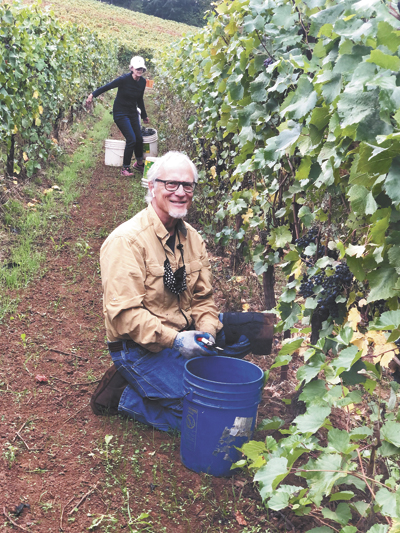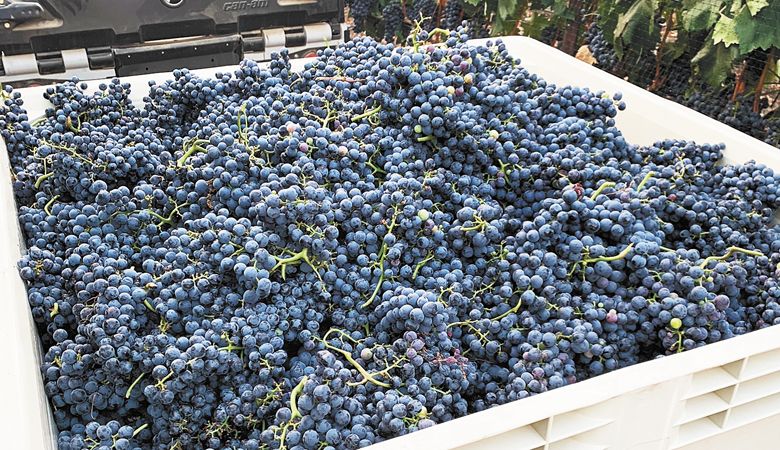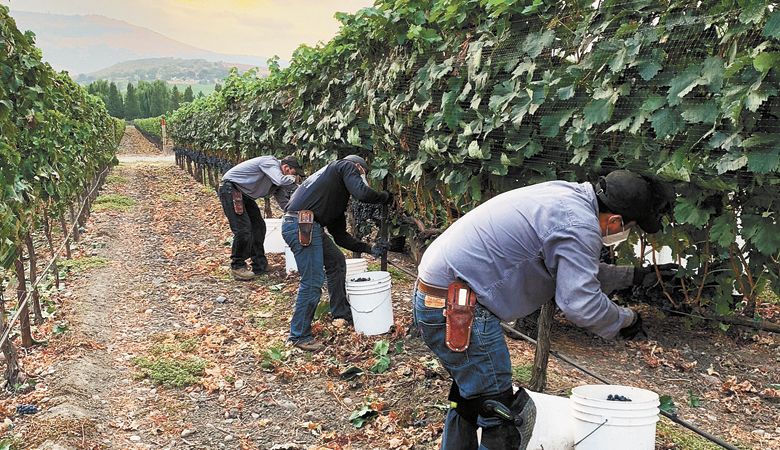Harvest 2020
Lower yields, high quality fruit and plenty of challenges make for historic vintage
By Paul Omundson
Oregon’s 2020 wine grape harvest is officially in the books and “in the rearview mirror of my truck,” said a smiling Terry Brandborg. “I’m glad that’s where it is.” The owner of Brandborg Vineyard & Winery and president of the Umpqua Valley Growers’ Association explained, “First, the virus, then smoke, and both of those brought a lot of challenges.”
Yet, there remains silver lining: remarkable fruit harvested during these past six weeks throughout the state’s AVAs. The richness and complexity of the grapes raise expectations that, despite numerous obstacles, this year might ultimately prove a good-to-excellent vintage. But while quality is up, quantity is definitely down.
Overall tonnage should reflect a 10% to 40% drop from last year’s 105,586 tons picked. That preliminary forecast reflects the diverse characteristics and varietals grown in Oregon’s 21 federally designated winegrowing areas, translating into total tonnage, ranging from approximately 63,000 to 95,000 — the Oregon Wine Board will post final numbers in its 2020 Oregon Vineyard and Winery Report in 2021 after surveying growers and winemakers.

As far as a drop in yield, it’s mostly a case of nature doing her thing. There were a number of factors possible in the drop, including yet-to-be-revealed smoke damage to fruit. But what happened on a fairly wide scale throughout Oregon was a climatic trend of wetter, cooler weather in mid-June bloom, precisely when it’s not wanted.
“In an ideal world, you’d have clear skies, lots of sun and moderate temperatures in a 70- to 80-degree range in that period,” said Greg Jones, research climatologist and director of the Evenstad Center for Wine Education in the department of environmental studies at Linfield University in McMinnville. “Otherwise, you risk having a loss of self-pollinating and blooms for fruit. Many areas had low temperatures, cloud cover and rain, not a lot but enough to keep solar radiation low. Those things led to smaller berries and cluster loss. It was strictly a yield impact and had nothing to do with fruit quality.
“Other than that brief period in June, we had moderately warm days that weren’t too hot along with cool nights,” he explained. “That produced a situation where the vines were able to rest in the evening and concentrate their efforts on developing more fruit complexity and flavor. We’ll see how these good factors transfer to a bottle of wine,” he added. “Everything I’ve heard from growers indicates very good quality. I think we’re going to see some highly prized wine coming from the 2020 vintage.”
Smoke and lack of labor present challenges
For two weeks beginning on Labor Day, wildfire smoke suddenly became an unavoidable signature of the 2020 harvest. California, Oregon and Washington are forever locked together in the nation’s and world’s perception of how the 2020 Northwest vintage, in general, will taste after the late summer fire and smoke spectacle. So it’s up to growers and winemakers in unaffected areas to let the public know the true quality of their wares.
Some locations in Oregon may have been mostly spared from wide-spread smoke damage, suggested by anecdotal evidence and quick bucket fermentations. “The answer right now is that we still don’t know,” Jones emphasized. “Fermentation has to go on a little longer, until the end of November, before tests can accurately gauge smoke damage.”
Oregon State’s Oregon Wine Research Institute, Washington State University and UC Davis have increased research into smoke phenols and their effects on grapes. Now, there’s new urgency to gain information tailored specifically to Oregon. While there have been past wildfires and smoke issues near vineyards in Southern Oregon and the Columbia Gorge, this is the first-ever statewide extended fire/smoke event; experts warn of more to come. Growers look to these experts for help in early testing and accurate means to gauge smoke’s threshold damage point in exposed grapes.
Another persistent issue for Oregon harvests, surfacing once again, was a lack of skilled contract laborers. This year, vineyard pickers not only needed COVID-19 masks, but also N-95 masks for smoke. The thin number of available workers hints that some may have decided to skip the grape harvest. The wine industry works closely with field labor groups to make Oregon a desirable destination for workers who have a lot of options, including picking more lucrative crops and going elsewhere to fill temporary jobs. The Oregon wine industry can take a bow for its effective virus control and extensive worker safety protocols in the vineyards that go beyond state-mandated requirements. No virus or other major group health issues arose during harvest. Unfortunately, the loss of older, veteran workers continues, and there’s no new generation in sight to replace them.
In the vineyards
The final days of harvest were hectic, exasperating, fun and, at times, exhilarating for Alex Sokol Blosser, second-generation co-owner with his sister, Alison, of Sokol Blosser Winery in the Dundee Hills near Dayton. By then, pickers were at a minimum, so he enlisted everyone he could, including his twin sons, Avery and Nikolas, other family, staff and friends. The excitement came when he took a moment to examine his fruit. “The flavors are phenomenal, and the colors are impressive,” he said. “So far, no signs of smoke effect, but it’s still too early to tell.”
He must wait another month, until almost the end of fermentation, when smoke damage can reveal itself in tests. That’s where exasperation could enter the wine picture. “We clearly have a big knowledge gap in smoke effect on wine grapes in Oregon. We need to close it quickly.” In the next breath, the newly elected president of the Oregon Winegrowers’ Association vowed “to fight like hell,” to convince legislators to double and even triple funds allocated by the federal government for the joint smoke/fruit research effort of Oregon State, Washington State and UC Davis. “We desperately need that research so we can apply it,” he said.
Like Sokol Blosser, Ross Allen, owner and vineyard manager of 2Hawk Vineyard and Winery in Medford, experienced a similar labor issue, also using his own in-house crew for picking. His harvest team of five, including himself, picked at three different harvest stages: early, middle and late. “That gave us different chemistry and different flavors that will come together to make an exceptional wine.” The president of the Rogue Valley Vintners Association is excited about the fruit quality. “[This year] was horrible on so many levels, but the bright spot of [2020] is fruit. It’s absolutely amazing.”
Even in the tucked away Rocks District of Milton-Freewater on the Oregon side of Walla Walla Valley, there were eight days of smoke, not to mention cool and wet weather at bloom. “The smoke has shown no signs yet of affecting wine grapes yet, but wet and chilly weather at bloom did have a slight negative effect on yield,” said Brooke Delmas Robertson of SJR Vineyard and Delmas Winery. Her business partner and father, Steve Robertson, was instrumental in elevating the small area to AVA status in 2015. Brooke is following in his footsteps; she was recently elected board director representing Eastern Oregon by members of the Oregon Winegrowers’ Association.
At times, harvest was a study in contrasts: Jessica Thomas, general manager of Sweet Cheeks Winery and Vineyard near Eugene in the Southern Willamette Valley, reported little to no cold, wet weather at bloom for her and other area vineyards. Not far away, Brandborg in Elkton noted up to a 50% drop in yield for him and nearby growers because of the cold, wet factors. Tom Danowski, OWB president, mentioned reports from growers that the smoky east side of the Eola-Amity Hills exhibited dramatically different conditions from mostly clear skies on the west.
Despite what’s happened in Oregon’s vineyards during the crazy year that’s been 2020, this year’s vintage looks promising.












